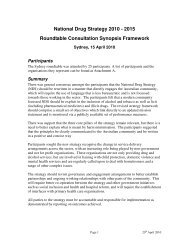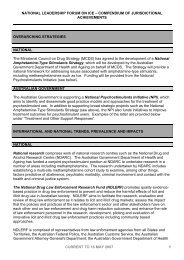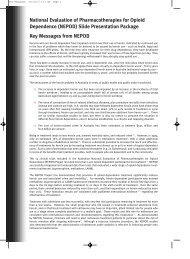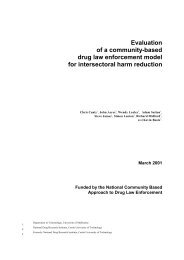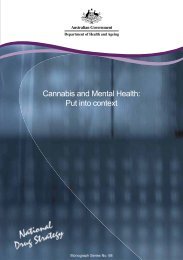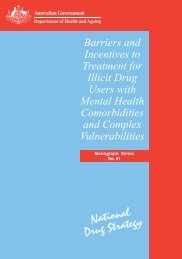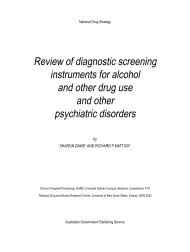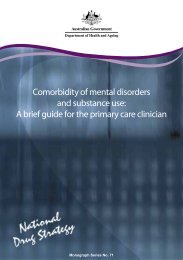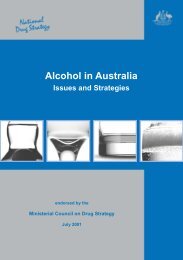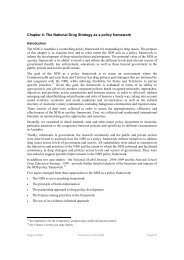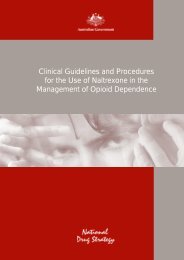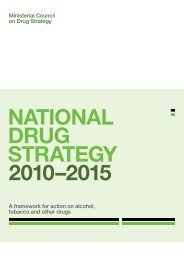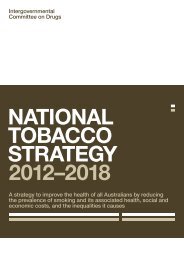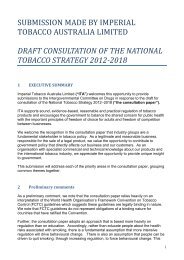A Guide for Frontline Workers - National Drug Strategy
A Guide for Frontline Workers - National Drug Strategy
A Guide for Frontline Workers - National Drug Strategy
You also want an ePaper? Increase the reach of your titles
YUMPU automatically turns print PDFs into web optimized ePapers that Google loves.
What does detoxification using buprenorphine involve<br />
Detoxification from heroin using buprenorphine involves taking a daily dose of<br />
buprenorphine <strong>for</strong> 4 or 5 days – tablets are placed under the tongue until they<br />
dissolve. In an outpatient program, buprenorphine is usually given once a day at the<br />
clinic or pharmacy. In an inpatient detox, dosing may occur several times a day. When<br />
buprenorphine is taken <strong>for</strong> a short period (e.g. 4 or 5 days), there are usually only<br />
mild withdrawal symptoms <strong>for</strong> 1 to 3 days after stopping buprenorphine.<br />
In a recent Australian research project, more heroin dependent people completed<br />
detoxification using buprenorphine than a ‘standard’ detoxification (clonidine and<br />
other medicines), and it was more likely to lead to ongoing treatment than any other<br />
method of detox tested.<br />
‘Rapid’ detoxification using naltrexone or naloxone is a more recently introduced<br />
method of detoxification that is not widely available, and is only an option <strong>for</strong><br />
selected people. In rapid detox, people are given naloxone (brand name Narcan®) or<br />
naltrexone (brand name Revia®) to speed up withdrawal, along with other medicines<br />
to reduce discom<strong>for</strong>t and help them cope with the procedure. The methods and<br />
medicines used vary, but in most programs people are sedated to some degree so<br />
they do not experience the worst of the withdrawal symptoms.<br />
By speeding up withdrawal, it seems more people are able to complete rapid detox<br />
than other types of detox, and start long-term naltrexone treatment. Naltrexone<br />
treatment may be a useful option <strong>for</strong> people who have decided on abstinence (see<br />
Naltrexone treatment in the Abstinence-Based Treatment section).<br />
Issues to consider about rapid detoxification<br />
Rapid detoxification does shorten the most intense part of withdrawal, but<br />
symptoms can continue <strong>for</strong> several days after the procedure, and be quite severe. For<br />
this reason, all rapid detoxification procedures must be carried out by specialist drug<br />
and alcohol personnel who can care <strong>for</strong> people as in-patients in case of severe<br />
withdrawal reactions.<br />
Rapid detox can cost up to several thousand dollars at some private clinics,<br />
depending on inclusions of the program, <strong>for</strong> example, counselling and naltrexone<br />
tablets needed following the initial procedure.<br />
Because of the risks and costs associated with rapid detox, it is not available in most<br />
states in the public health system – it is mostly done through private hospitals. Note<br />
that naltrexone is not currently registered in Australia <strong>for</strong> rapid detox. It is very<br />
important that treatment providers in<strong>for</strong>m people fully of the possible risks of rapid<br />
detox (in writing) and other treatment options.<br />
8<br />
Naloxone (also known as Narcan®) is used to reverse the effects of heroin overdose,<br />
and sometimes used in rapid detoxification to speed up withdrawal.



